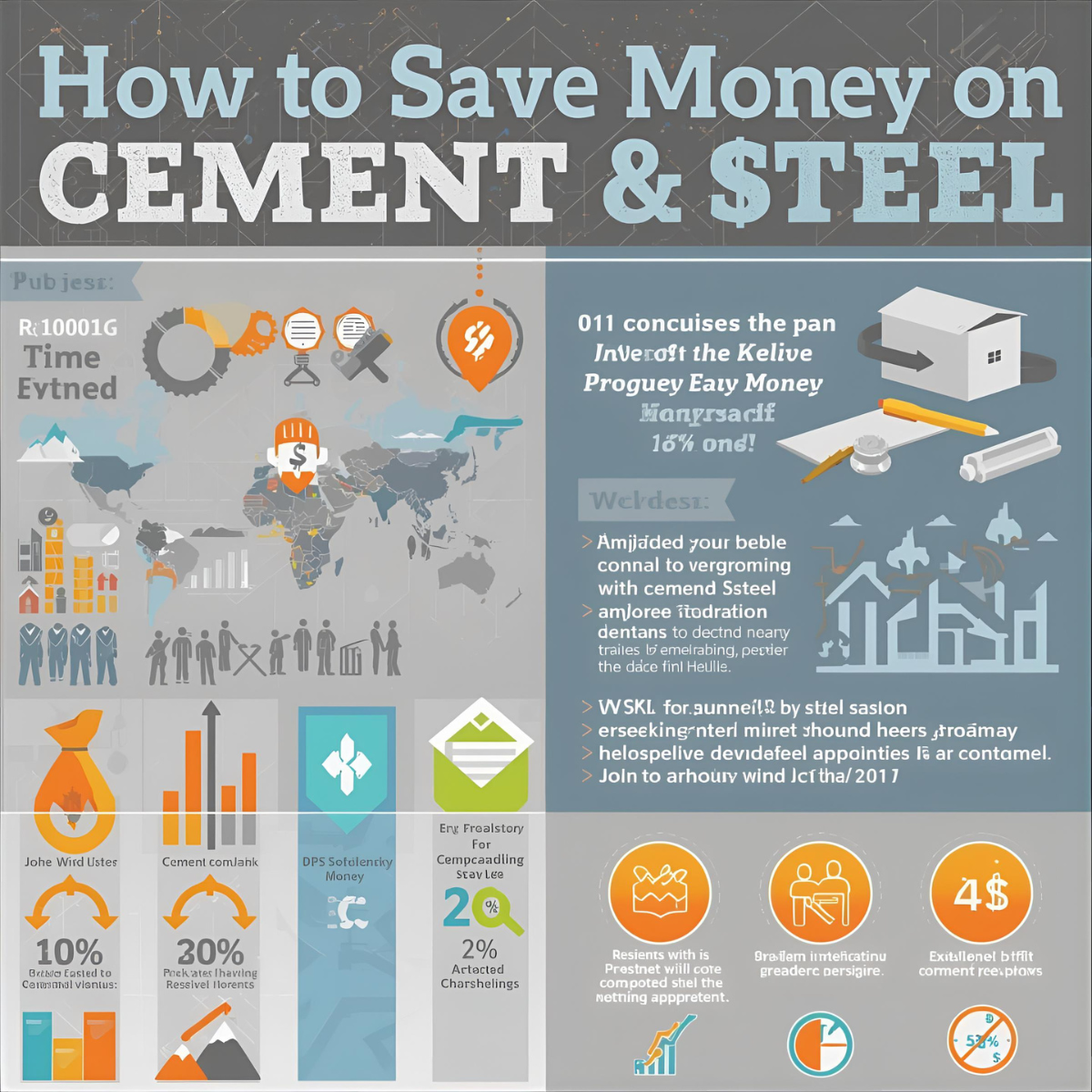When it comes to construction, cement and steel are the two biggest cost drivers. Whether you are building a home, a commercial complex, or even a large-scale industrial project, the share of cement and steel in the overall budget is massive. Many people often struggle with rising costs and fluctuating market prices, which can disrupt planning and increase expenses. But there is good news – if you know the right strategies and understand how bulk purchasing works, you can save a significant amount of money on cement and steel without compromising on quality.
This article is a complete guide that explains how you can cut costs smartly, what mistakes to avoid, and how bulk orders can actually benefit you in the long run. Instead of a complex technical approach, we will use simple language so that even a first-time builder or homeowner can follow these tips with confidence.
Understanding Why Cement and Steel Costs Matter
Cement and steel together form the backbone of any construction project. Cement is essential for concrete work, plastering, flooring, and structural strength, while steel provides the reinforcement needed to withstand loads, weather, and time. These two materials alone can make up nearly 40–60% of the total construction cost, depending on the project size.
Now imagine if you could save even 5–10% on cement and steel. For a home costing ₹30–50 lakhs, this could mean savings of several lakhs. For large builders and contractors, the savings can run into crores. This is why learning the art of smart bulk buying is not just about cost-cutting – it’s about making your project financially efficient.
Why Bulk Orders Make Sense
Buying cement and steel in bulk might feel overwhelming because of the upfront investment. But when you analyze the financial benefits, it becomes clear that bulk orders are the smarter route. Manufacturers and suppliers often offer price relaxations when you commit to larger quantities. For them, bulk sales reduce marketing and distribution costs, which allows them to pass some of the savings on to you.
Bulk buying also reduces the risk of sudden price hikes. The cement and steel market is volatile and prices can rise unexpectedly due to fuel costs, demand fluctuations, or changes in government policy. If you lock in your requirement with a bulk order in advance, you can shield yourself from these fluctuations. In simple words, you are freezing today’s price for future use.

Planning Before You Purchase
One of the biggest mistakes buyers make is rushing into bulk purchases without proper planning. You cannot simply call a supplier and order 500 bags of cement or 50 tons of steel without calculating your real requirement. Cement, for example, has a shelf life of about three months if stored properly, and steel requires safe, dry storage to avoid rust. If you buy more than what you can use within a reasonable period, you will end up with waste, and the money saved initially will get lost.
The first step is always estimation. Work with your engineer, architect, or contractor to calculate the exact cement and steel requirement for each phase of your project. Once you have a clear picture, divide the order into two or three lots based on construction timelines. This way you enjoy the benefits of bulk pricing while also ensuring safe usage.
Building Relationships with Trusted Suppliers
In the world of construction, relationships matter. If you want to save money on cement and steel, you need reliable suppliers who can give you the best rates without compromising on quality. A one-time purchase may not give you much negotiation power, but if you build a long-term relationship with a dealer or distributor, they are more likely to offer you discounts, priority delivery, and flexible payment terms.
Many reputed suppliers also give special prices to repeat customers. They understand that steady clients bring them consistent business, so they reward loyalty. Therefore, instead of switching from one shop to another in search of a small difference, stick to a supplier who values your business and is willing to cooperate with you.
Taking Advantage of Seasonal Trends
The demand for cement and steel often changes with the season. For example, during monsoon, many construction projects slow down, and suppliers may reduce prices to maintain sales. Similarly, at the end of a financial quarter, distributors often try to clear their stock to meet targets, and this is when you can negotiate better rates.
By aligning your bulk purchases with such trends, you can save a lot. For instance, buying cement right before the peak construction season can lock in a lower price, protecting you from the inevitable price hikes that follow when demand rises sharply.
Negotiation is Key
A very simple but often overlooked way to save money is negotiation. Suppliers usually quote a higher price first, expecting buyers to bargain. If you are confident and informed about the market rates, you can always negotiate. The more quantity you buy, the stronger your negotiation power becomes.
Even if the discount seems small on each bag of cement or each ton of steel, when multiplied by hundreds of units, the savings add up to a big figure. Always ask for delivery charges to be included in the deal, because transport costs can silently increase your expenses. A good negotiator doesn’t just look at price per unit but at the overall landed cost.
Importance of Quality in Cost-Saving
Some people mistakenly think saving money means buying the cheapest cement or steel available. But in construction, low quality leads to long-term damage, which will cost you far more in repairs and replacements. Cracks, weak structures, or rusting reinforcement can destroy years of investment.
The real strategy is to save money on genuine branded materials by using smart buying practices, not by compromising on standards. Always check for certification marks, batch numbers, and authorized dealer invoices when purchasing in bulk. This ensures that you get authentic material at a fair price.

The Role of Storage and Logistics
When you buy in bulk, storage becomes a crucial factor. Cement must be stored in a dry, covered space, preferably on raised platforms with proper ventilation, to prevent moisture absorption. Steel rods and bars should be kept away from direct rain or dampness to avoid rusting.
If you don’t have adequate storage, you may lose a part of your material to damage. This loss eats into the savings you made during purchase. Therefore, before placing a bulk order, arrange safe storage facilities. Some suppliers even offer warehouse storage and phased delivery at no extra cost if you negotiate properly.
Exploring Direct-from-Factory Options
Another way to save money is by avoiding too many middlemen. Many cement and steel brands allow large buyers to purchase directly from their authorized plants or stock points. The closer you are to the source, the lower the price, because every extra dealer or distributor in between adds a margin.
For big projects, this strategy is very effective. Even for smaller projects, if a group of homeowners or contractors come together to form a purchase group, they can place a collective bulk order directly from the factory, cutting down costs significantly.
Digital Platforms and Online Deals
In today’s world, construction material can even be purchased online. Many e-commerce platforms and dedicated construction material marketplaces allow bulk ordering of cement and steel. These platforms often display transparent prices, offer discounts on higher quantities, and provide doorstep delivery.
The digital approach also makes comparison easier. Instead of calling ten suppliers one by one, you can check online rates in minutes and choose the best deal. This competitive environment pushes suppliers to offer better prices, which ultimately benefits the buyer.
Long-Term Vision Saves More
If you are planning multiple projects or even future expansions, think long term. Bulk orders should not just be about today’s construction but also about securing material for tomorrow. For builders and developers, tying up with suppliers for a year-long contract can lead to massive savings.
Even homeowners who plan phased construction – for example, building the ground floor first and later adding more floors – can negotiate bulk supply agreements spread across time. Such planning ensures stable costs and reduces stress during later stages.

Conclusion – Smarter Buying, Stronger Savings
Cement and steel are not just materials; they are investments into the foundation of your dream. Saving money on them does not mean cutting corners but buying smarter. Bulk orders are one of the best ways to achieve this, provided you plan carefully, negotiate effectively, store properly, and never compromise on quality.
By building strong supplier relationships, timing your purchases well, and using direct or digital channels, you can achieve significant savings. Whether you are an individual constructing your first home or a builder managing multiple projects, these strategies will help you make your budget work harder.
At the end of the day, construction is about more than walls and beams – it’s about creating lasting value. When you save money wisely on cement and steel, you are not only reducing costs but also ensuring that your project stands strong, beautiful, and within budget.
